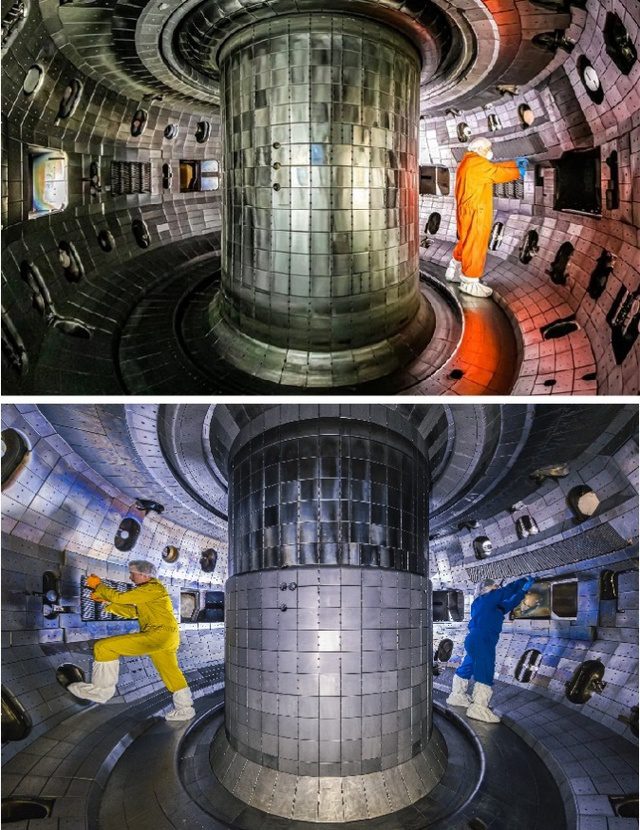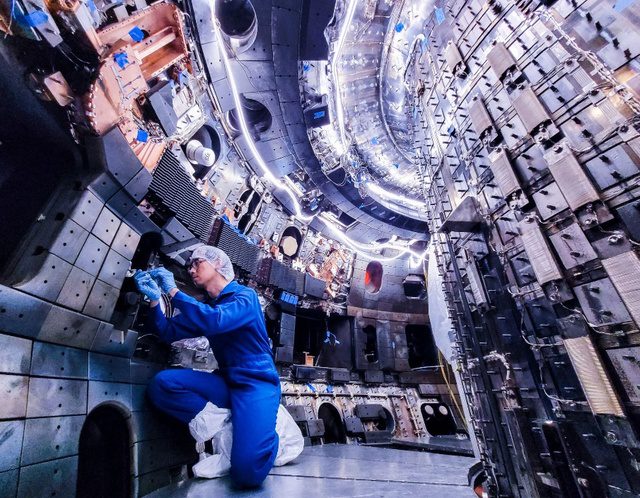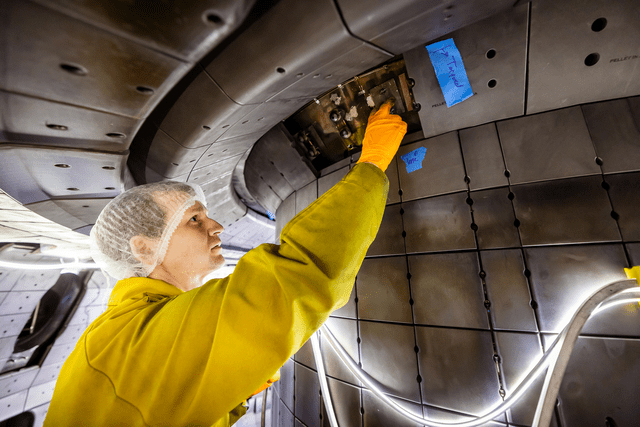National Fusion Facility Completes Upgrade
Enhancements will enable research into the physics of advanced fusion reactors and accelerate the drive to commercial fusion energy.
The DIII-D National Fusion Facility has completed a series of important enhancements, providing researchers with several first-of-a-kind tools for controlling and understanding the function of fusion plasmas. These upgrades will further strengthen DIII-D’s standing as one of the most flexible and capable magnetic fusion research facilities in the world and help close key physics gaps between current experiments, the first fusion pilot plants (FPPs), and future fusion reactors.
“The upgrades made to DIII-D over the last eight months provide us with exciting new capabilities and key enhancements to existing systems for studying fusion energy,” DIII-D Director Richard Buttery said. “Our scientists will be able to use our upgraded systems and diagnostics to answer key questions on commercial industry–relevant technology, materials, and operations, as well as continue our support of ITER and advancement of foundational scientific understanding.”
DIII-D is a U.S. Department of Energy (DOE) Office of Science user facility and a world-class fusion laboratory where more than 700 researchers from more than 100 domestic and international institutions—including U.S. national laboratories, academic institutions, and industry—explore a wide range of topics from fundamental plasma science to fusion power plant operations.
At the heart of the facility is the DIII-D tokamak, a toroidal (doughnut-shaped) vacuum chamber surrounded by powerful electromagnets that confine plasmas—a state of matter with large quantities of ionized particles—at temperatures exceeding 10 times those of the Sun. At these high temperatures, hydrogen isotopes fuse together and release energy.
The facility has been offline since July 2023 as a multi-institutional team of engineers and technicians worked to install new capabilities. These include systems for enhanced control of fusion plasmas; a range of new diagnostic instruments; enhanced capabilities for heating plasmas and driving the current that supports the fusion reaction; and enhancements to the divertor system that removes exhaust heat and impurities from the tokamak.
Together, the new technologies installed during the eight-month upgrade (Figure 1) will play a key role in developing the scientific basis for fusion as a reliable and nearly limitless energy source. When experiments restart this month, researchers will use these tools to optimize the performance of fusion plasmas and help bring practical fusion energy closer to reality.

Enhanced Plasma Control
DIII-D’s plasma control system (PCS) is a key tool for researchers in shaping and controlling fusion plasmas during experiments. Upgrades to its computational and diagnostic capabilities will allow for more rapid development and deployment of new and increasingly complex real-time control and analysis techniques in support of research on DIII-D. The upgrades include 32 new processing cores that were added to the PCS real-time computing systems, additional signals from diagnostic instruments for additional data inputs, and improvements to real-time signal filtering.
New Diagnostics
The diagnostic upgrades include a mix of new instruments (Figure 2) and new support systems to enhance the performance of existing instruments. These instruments will provide more accurate measurement of important characteristics of DIII-D plasmas.

One method for handling the intense power exhausted by the plasma is to maintain neutral gas in the wall region where the exhaust is directed. To better understand how the plasma exhaust interacts with this background gas it is necessary to measure the distinct gas pressures of each present species; however, traditional pressure gauges are ineffective in the presence of strong magnetic fields. As a solution, DIII-D scientists devised an innovative method using light emissions to gauge pressure. This instrument, called a Wisconsin Penning gauge, measures the pressures of different gases that accumulate near the wall.
Due to the extremely harsh plasma environment, the main wall of a future fusion reactor will be made of robust metals such as tungsten. However, tungsten impurities (and other elements high on the periodic chart) can cause significant cooling of the plasma. To better study the transport behavior of tungsten and similar elements, as well as the associated effects, existing systems were given a larger ultraviolet (UV)-transparent window and diagnostic platform to enable a much wider view and more flexibility in the viewing region.
Another instrument, the Radial Interferometer Polarimeter (RIP), provides measurements of the equilibrium and behavior of the magnetic fields. The RIP system was upgraded to improve its sensitivity and range of measurement while also expanding its sensitivity to the 3D-characteristics of these fields.
The radiated power from plasmas can be measured by an instrument known as a bolometer. However, thermal stability and electromagnetic interference are common issues with conventional bolometers. DIII-D scientists developed a new instrument that avoids interference with a measurement approach that does not use electronics. The Fiber-Optic Bolometer is an optical device that measures radiated power using an interferometer to convert radiation into temperature variations, which are measured from the shift in the reflection spectrum.
A system known as Charge Exchange Recombination (CER) Spectroscopy is used to measure temperature, density, and behavior of the plasma. A subset of the components in this system known as MiCER is used to measure emissions from the hydrogen fuel. A new MiCER system that allows measurement of higher energy particles near the divertor has been installed. This new system will be used to improve understanding of boundary plasma physics.
Enhanced Heating and Current Drive
FPPs and future power plants will require much more powerful systems to create and drive the fusion reaction. The new, more efficient systems added to DIII-D will allow researchers to access plasma regimes that scale well to advanced FPP scenarios. These scenarios have an elevated “plasma beta,” which is a metric for energy produced from the plasma compared to the amount of energy needed to confine it.
The new Lower Hybrid Current Drive system was installed during the upgrade period and now enters the commissioning phase to establish operation of all associated subsystems in preparation for future experiments. This system incorporates first-of-its-kind additively manufactured (AM) components, called waveguides, that carry microwave heating energy. The use of AM allows for design features that cannot otherwise be manufactured.
The system also adds eight new microwave generating units, called klystrons, that deliver heating and current to the DIII-D plasma via the new AM waveguides. This is a high-field launch system, meaning microwaves are transmitted to the plasma from the center post rather than the outside edges. Modeling predicts this location will lead to higher efficiency because it enables the microwaves to be absorbed on their first pass through the plasma, which also limits the potential for escape and damage to the tokamak interior. The Lower Hybrid Current Drive system will provide the first-ever demonstration of this high-field launching approach.
Divertor Upgrades
During operation, a tokamak must be able to remove excess heat, impurities in the plasma, and fusion byproducts on an ongoing basis. A system known as the divertor serves this role, but additional research is necessary to determine optimal divertor design and configuration for fusion power plants. This challenge has been identified by the fusion community as one of the key questions for extrapolating current tokamak plasmas to FPP scenarios.
A new configuration called a Shape and Volume Rise (SVR) divertor (Figure 3) is the first of a series of modular divertor configurations that DIII-D will test in its near-term research plan, with the goal of developing a high-performance scenario at more FPP-relevant conditions. In particular, the new design will enable access to plasma shapes that are expected to produce high fusion power performance but were not possible with the previous divertor geometry. SVR is designed for efficient removal of plasma impurities to allow better control of the plasma density. This will enable researchers to close key physics gaps between current experiments and future fusion reactors.

DIII-D is the largest magnetic fusion research facility in the U.S. and has been the site of numerous pioneering contributions to the development of fusion energy science. As a U.S. Department of Energy, Office of Science User Facility, participation in DIII-D research is open to all interested parties. For more information, visit d3dfusion.org.
—POWER edited this content, which was contributed by General Atomics’ public affairs department.